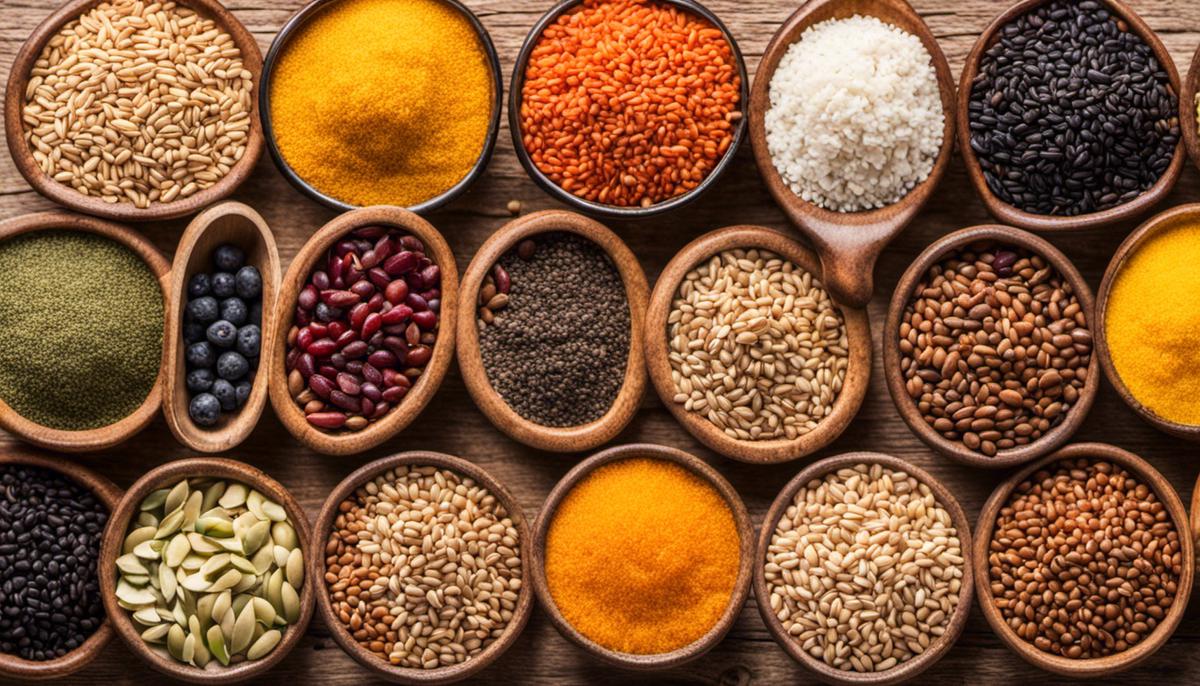As a central pillar of a balanced diet, protein fuels our bodies, supports muscle growth, and keeps us satiated throughout the day. But consuming enough protein is about more than just guzzling shakes and chowing down on chicken breasts. The world of protein-rich foods is vast, varied, and offers an array of rich taste and texture options, encompassing both animal-based and plant-based sources. Beyond sheer quantity, knowing how to cook these foods correctly can greatly influence your body’s ability to absorb and use their protein content. Additionally, integrating these powerhouse foods into your everyday meals and exploring how to leverage protein in your dining-out experiences will ensure you fully enjoy the advantages of these protein treasures.
Unmasking the Protein Powerhouses
The Protein Infusion: A Foodie’s Guide to High-Protein Foods
For the adventurous palates who constantly chase behind the alchemy of flavors, and for everyone who reveres the kitchen as their playground, it’s a universally acknowledged truth that food is more than just survival fuel. It’s an intricate dance of nutrients that caters not only to our taste buds but also to our well-being. One such pivotal nutrient that has been the talk of the gourmet town is protein.
By now, almost everyone acknowledges that proteins are the building blocks of life. Why? Simply because every cell within the human body comprises proteins. It’s the powerhouse nutrient responsible for repairing cells, making new ones, and contributing to growth and development. But the billion-dollar question we all have in mind is – what foods contain the highest amount of proteins?
Let’s embark on a culinary adventure together and discover some high-protein food stars. There’s more to protein than the standard fare of chicken breasts and eggs, after all.
-
Seafood:
Sea is indeed a treasure chest of protein! Most seafood is low in fat, and fishes like salmon, albacore tuna, and sardines also offer the fantastic omega-3 fatty acids bonus. Shrimp, another sea-resident, sits on the highest protein throne with around 20 grams of protein in a 3-ounce serving and very low-fat content.
-
Poultry:
Lean poultry, such as chicken and turkey, are protein-dense and low-fat alternatives to red meat. Chicken takes pride in its impressive track record of around 25 grams of protein per 3-ounce serving.
-
Dairy Products:
Exceptionally versatile and endearingly delicious, dairy products are an excellent source of protein. Greek yogurt, cottage cheese, and skimmed milk take the lead. And for all the cheese lovers out there, Swiss cheese packs a protein punch.
-
Eggs:
Eggs are an accessible, affordable, and highly nutritious protein source that enjoys worldwide popularity. That’s 6 grams of protein housed in one versatile enough-to-be-eaten-anyway-you-want-egg!
-
Lean Meats:
Red meat, notably lean cuts, like top round and lean pork, are rich in several vitamins and minerals along with protein.
-
Plant-Based Proteins:
For those following plant-based diets, don’t you fret! Nature is teeming with protein. Lentils, quinoa, soy products, chickpeas, and a wide range of beans and seeds are high in protein. Another spectacular plant-based protein sources are peas; yes, you heard that right!
-
Nuts and Nut Butters:
While they contain fats, it’s the good, heart-healthy fats found in almonds, pistachios, and walnuts. Nut butter, specifically peanut butter, also provides considerable protein.
So there it is, a small glimpse into the world of high-protein foods. It’s worth mentioning that a balanced diet, proper cooking methods, and consuming all nutrients in moderation are the key to optimal health. Now, here’s to exploring and enjoying a protein-rich journey entwined with endless exciting flavors and health benefits galore!

Culinary Techniques for Optimal Protein Absorption
Harnessing Wholesome Proteins: Optimal Cooking Techniques for Superlative Absorption
In the world of culinary delights and dietary science, an important consideration is how to ensure maximum protein absorption. It’s not all about the particular choice of protein rich foods, such as seafood, poultry, dairy products, eggs, lean meats, plant-based proteins or nuts. The trick is in the clever application of appropriate cooking methods.
To commence with a stab at viscerally nourishing and mighty legumes; lentils, chickpeas, beans, you name it – these powerful plant proteins thrive when they’re soaked and cooked. Scientifically speaking, soaking helps to eliminate phytic acid, a naturally occurring compound that can reduce our bodies’ absorption of essential nutrients like protein. Boiling or pressure-cooking soaked legumes then makes the protein much easier for the body to utilize.
Next on the list, the versatile and ubiquitous tofu, a treasure trove of plant-based protein. Pressing out the excess water, and baking or grilling can increase the density of the protein. Bonus points, if marinated first, the flavors are amplified, lending this humble bean curd a stellar taste and texture profile!
Turning to quinoa, a grain packed with all essential amino acids, therefore entirely protein-complete! As with legumes, rinsing followed by simmering is recommended for an absorption-friendly outcome. Furthermore, it’s recommended to consume grains like quinoa with Vitamin C-rich foods, as this increases plant protein absorption.
Jumping aboard the carnival of proteins, don’t forget the crowd favorite – Greek yogurt. Consume it raw or incorporate it in sauces and dips rather than heating to lethally high temperatures that can denature proteins, making it hard for the body to absorb their wholesome goodness.
And then, of course, there is cheese. The delectable gift to our palate! In the quest for protein absorption, it’s best enjoyed raw, or melted on toast or baked into casseroles. Heating cheese to high temperatures isn’t advisable, as it can cause proteins to toughen and lose their bioavailability.
Last, but not least, the humble egg, versatile and rich in protein, be it sunny-side-up, poached, or boiled, cooking eggs changes the structure of their proteins, making it easier for our bodies to harness their protein power. However, it’s worth noting that overcooking can lead to loss of certain nutrients, so a gentle cooking method is preferred.
In conclusion, let’s all raise a toast to the joyous dance between food and scientific understanding, one which guarantees not only a delightful eating experience but a nutritional bonanza too. Remember, the perfect balance in the world of proteins is about considering both what we eat and how we cook it. Now, equipped with this wisdom, we can relish in delicious protein-rich meals, secure in the knowledge that our body is absorbing all it needs. Happy eating!

Protein-Packed Recipes
When it comes to creating delicious, high-protein meals, the world of grains and seeds is a culinary goldmine waiting to be tapped. They’re delightful little packages of nutrients that can be prepared in numerous ways to form a tantalizing centrepiece of any dish.
Quinoa, buckwheat, chia seeds, and ground flaxseeds – these names might sound a bit exotic, but they’ll soon be your new best friends when crafting delicious high-protein meals. Chia seeds and flaxseeds, for instance, are packed with protein and can easily be incorporated into any dish, whether that’s a tempting bowl of morning oatmeal or a hearty homemade bread loaf. Just remember, when dealing with flaxseeds, it’s best to consume them ground to unlock their full nutritional potential.
Next on the menu – grains. They play an important role in lending a profound texture and taste to the dishes. Take a culinary trip around the world and you’ll realize each region has a beloved grain; Bulgur in the Middle East, Barley in Europe, Millets in India- their versatility brings joy to the kitchen and plenty of proteins to the plate. For instance, Bulgur, with its mildly nutty flavor, makes an excellent base for tangy tabbouleh salad or serves as a wondrous replacement for rice in a pilaf.
Embracing green leafy vegetables, particularly ones like spinach and kale, is an excellent approach too. Sure, they may not be particularly high in protein compared to some other sources, but when they are tossed into a salad or blended into a green smoothie, they play an important role in amping up your protein intake.
One cannot forget soy products either. Tempeh, for instance, is a fermented soy product that boasts flavors of earthiness and subtly sweet undertone. Teeming with protein, tempeh can be baked, sautéed, or grilled to perfect crispy exteriors while maintaining a juicy center.
Lastly, seeds, such as pumpkin seeds, poppy seeds, and sunflower seeds, are tiny powerhouses of protein. They can be lightly toasted to unveil their nutty essence and tossed into salads, sautéed along with vegetables, or sprinkled on sweet or savory bakes.
Creating delicious and high-protein dishes is as much about discovering overlooked ingredients as it is about experimenting and adopting new culinary approaches. It’s an adventure that mixes nutrition with delicacy, creating plates that delight the palate while filling the body with the energy it needs. In the end, it’s all about that crave-worthy balance between taste and nutrition. Go forth and conquer your kitchen with protein-packed delicacies!

Proteins and Dining Out
Let’s journey a bit further down the gastronomical pathway of high-protein glory! Embark with us on this delicious adventure, where the road weaved with robust flavors intersects with the avenue adorned with nutritional wisdom. We’ll be taking a closer look at avenues less explored, yet brimming with delectable, high-protein delights.
In the kaleidoscopic landscape of high-protein options, insects aren’t usually the first course of action. Yet, around the globe, crunchy critters form a significant part of people’s diets. Packed with protein, essential fats, and vitamins, insects like crickets, mealworms, and silkworms are becoming increasingly popular culinary elements. Fancy an exotic touch? Remember, an adventurous palate can uncover surprising culinary treasures.
Next stop on our global protein tour brings us to the land of the rising sun, Japan. Here, one can relish the nutritional powerhouse of natto, a fermented soybean delicacy. Its unique, somewhat pungent aroma and gooey texture may be an acquired taste for some, but the protein payload it delivers is undeniable. Plus, it’s a potent source of probiotics and vitamin K2.
Speaking of probiotics, let’s not forget the deliciously sour world of fermented foods! Kimchi, a tantalizing Korean side dish made from fermented vegetables and spices, contain various health benefits along with its protein punch. Likewise, sauerkraut and pickled cucumbers also offer unique takes on savory, protein-enriched sides.
Beyond the land and sea, we find protein in an unlikely place – fungi. Yes, mushrooms, specifically the portobello and shiitake varieties, are excellent sources of protein. Grilled, sautéed, or stewed, their umami taste adds an incredible depth of flavor to dishes, all while ticking the nutritious high-protein checkbox.
Quinoa, buckwheat, and amaranth are not your typical side dishes, but these pseudo-grains promise a protein-rich dining experience. Whether it’s the crunch of a buckwheat pancake, the heartiness of a quinoa salad, or the comfort in a bowl of amaranth porridge, these are truly versatile foods worth exploring.
Lastly, we turn to the rich flavors of the sea. Unexplored by many, the marine plants, notably seaweed and spirulina, harbor high levels of protein. Layered into sushi rolls, tossed into salads, or infused into smoothies, these sea greens offer a quirky yet health-happy twist to regular meals.
Remember, the universe of high-protein foods extends far beyond the familiar path. With it comes the joyful thrill of experimenting with audacious flavors and textures from different regions, pushing the boundaries of nutrition and taste. Embrace the journey of discovering exotic, high-protein delights, and relish the satisfaction that comes from creating and sharing food experiences that nourish both the body and soul.

By diving into kitchens across the globe and detailing restaurant offerings, we hope that we have illustrated the breadth and appeal of protein-rich foods. Exploring high-protein options isn’t just about meeting dietary requirements—it’s also a journey of culinary discovery, brimming with diverse flavours and textures. Whether you’re inclined to don the apron and experiment in your own kitchen or prefer relishing a delicious chef-prepared meal, proteins surely take a center stage, helping you lead a healthful and zestful life. So go ahead—bring a spark of innovation to your dining table or broaden your dining horizons and enjoy the feeling of fullness and satisfaction that protein-powered meals bring.
